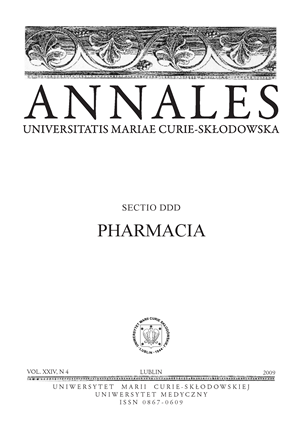Interaction of norfloxacin and sparfloxacin with melanin in vitro in relation to phototoxic reactions
Abstract
The aim of this study was to examine in vitro the binding capacity of fluoroquinolone derivatives: norfloxacin and sparfloxacin, causing adverse phototoxic effects in the eye and skin structures, to DOPA-melanin. The analysis of results concerning the kinetics of drug-melanin complexes formation showed that the amount of drug bound to melanin increases with increasing initial drug concentration and prolongation of incubation time. The analysis of drugs binding to melanin has shown that at least two classes of independent binding sites must be implicated in these complexes formation: strong binding sites (n1) with the association constant K1~104 M-1 for norfloxacin and K1~105 M-1 for sparfloxacin complexes and weak binding sites (n2) with K2~102 M-1. The demonstrated ability of norfloxacin and sparfloxacin to interact with DOPA-melanin in vitro is discussed as one of the risk factors of their phototoxicity in vivo.
References
1. Binns F., Chapman R. F., Robson N. C. et al.: Studies related to the chemistry of melanins. Part VIII. The pyrrolecarboxylic acids formed by oxidation or hydrolysis of melanins derived from 3,4-dihydroxyphenethylamine or (±)-3,4-dihydroxyphenylalanine. J. Chem. Soc. C., 1128, 1970.
2. Hamanaka M., Mizutani H., Asahig K., Shimizu M.: Melanocyte melanin augments sparfloxacin-induced phototoxicity. J. Dermatol. Sci., 21, 27, 1999.
3. Hu D.N.: Photobiology of ocular melanocytes and melanoma. Photochem. Photobiol., 21, 465, 2005.
4. Kalbitzer H.R., Stehlik D.: On the analysis of competitive binding of various ligands to cooperative and independent binding sites of macromolecules. Z. Naturforsch. C., 34, 757, 1979.
5. Ohshima A., Seo N., Takigava M., Tokura Y.: Formation of antigenic quinolone photoadducts on Langerhans cells initiates photoallergy to systemically administered quinolone in mice. J. Invest. Dermatol., 114, 569, 2000.
6. Ono C., Tanaka M.: Binding characteristics of fluoroquinolones to synthetic levodopa melanin. J. Pharm. Pharmacol., 55, 1127, 2003.
7. Owens R.C., Ambrose Jr.: Antimicrobial safety: focus on fluoroquinolones. CID, 41, 144, 2005.
8. Shimoda K., Ikeda T., Okawara S., Kato M.: Possible relationship between phototoxicity and photodegradation of sitafloxacin, a quinolone antibacterial agent, in the auricular skin of albino mice. Toxicol. Sci., 56, 290, 2000.
9. Thompson A.M.: Ocular toxicity of fluoroquinolones. Clin. Experiment. Ophthalmol., 35, 566, 2007.
10. Tolleson W. H.: Human melanocyte biology, toxicology, and pathology. J. Environ. Sci. Health, 23, 105, 2005.
Downloads
Published
Issue
Section
License
Copyright (c) 2009 Authors

This work is licensed under a Creative Commons Attribution-NonCommercial-NoDerivatives 3.0 Unported License.


